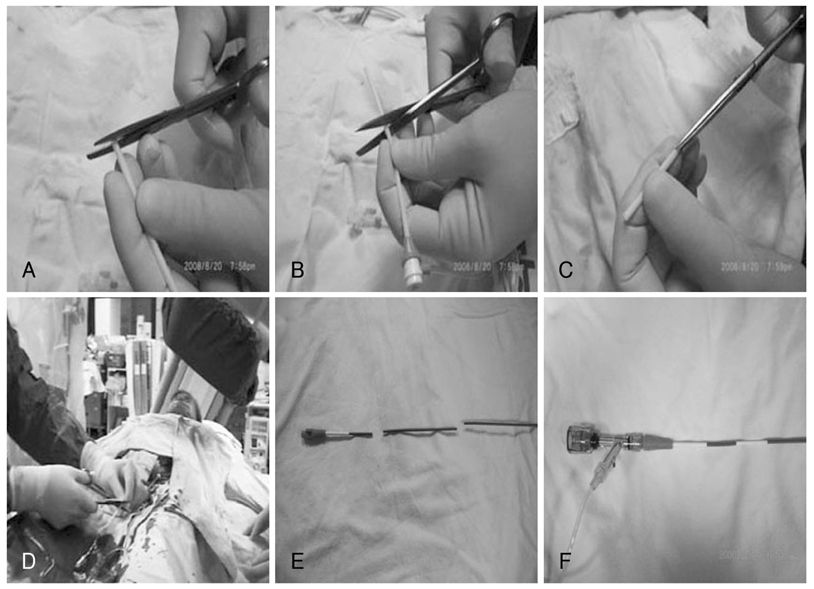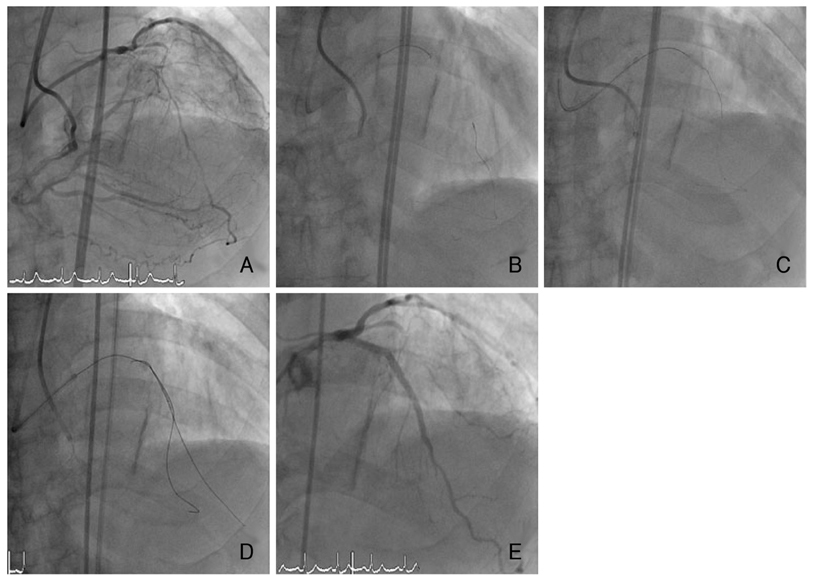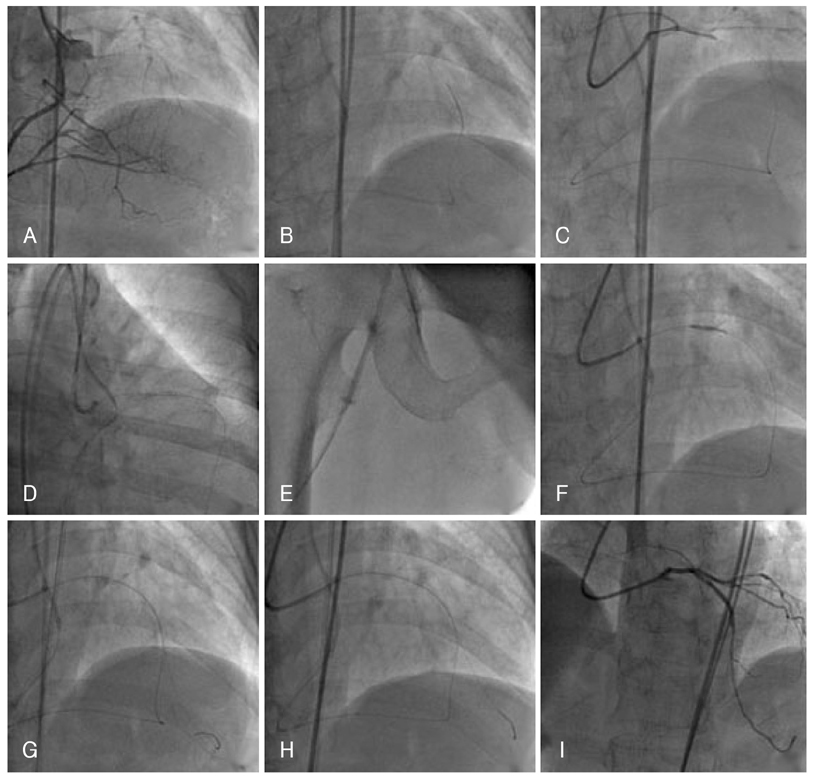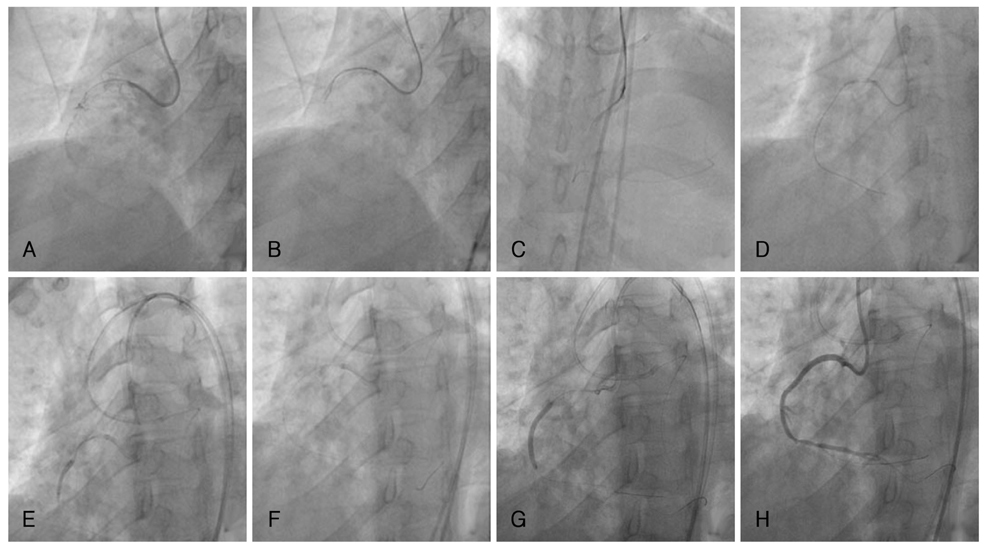Korean Circ J.
2009 Jun;39(6):228-235. 10.4070/kcj.2009.39.6.228.
Initial Experience of Retrograde Wire Approach in Coronary Chronic Total Occlusion Intervention
- Affiliations
-
- 1Department of Internal Medicine, College of Medicine, Dong-A University, Busan, Korea. kimmh@dau.ac.kr
- KMID: 1490698
- DOI: http://doi.org/10.4070/kcj.2009.39.6.228
Abstract
-
BACKGROUND AND OBJECTIVES: Retrograde wire approach has been emerged as a useful tool to enhance success rate in coronary chronic total occlusion (CTO) intervention. Therefore, we tried to report the initial experience of retrograde approach and its clinical implication on CTO intervention.
SUBJECTS AND METHODS
From February 2007 to July 2008, retrograde approaches were performed in 28 patients with 31 CTO lesions out of 61patients. A hydrophilic coated guidewire was inserted by using microcatheter or over-the-wire (OTW) balloon through the collateral channel (septal or epicardial artery) via several strategies.
RESULTS
Mean age of patients was 63.4+/-11.6 years. Male and female were 20 and 8 patients, respectively. The target artery with CTO lesions included the right coronary artery (45.2%), the left anterior descending artery (51.6%), and the left circumflex artery (3.2%). The mean length of CTO lesion was 18.4+/-16.4 mm. Overall technical success rate was 64.5%. The success rate of primary attempt was 78.9%, while the success rate of immediate and secondary attempt was 41.7%. Collateral channel dissections were observed in 3 patients and no patients among these patients developed cardiac tamponade. One patient had a silent non-Q wave myocardial infarction (MI) after the procedure. One failed patient died suddenly 3 days after the procedure. After percutaneous coronary intervention (PCI) procedure, no case was performed target vessel revascularization (TVR), urgent coronary artery bypass graft (CABG), and urgent PCI.
CONCLUSION
Retrograde approach is an evolving technique to improve the success rate of CTO intervention. After the learning curve period, this technique could be the useful tool to enhance success rate in CTO intervention.
Keyword
MeSH Terms
Figure
Reference
-
1. Warren RJ, Black AJ, Valentine PA, Manolas EG, Hunt D. Coronary angioplasty for chronic total occlusion reduces the need for subsequent coronary bypass surgery. Am Heart J. 1990. 120:270–274.2. Ivanhoe RJ, Weintraub WS, Douglas JS Jr, et al. Percutaneous transluminal coronary angioplasty of chronic total occlusions: primary success, restenosis, and long-term clinical follow-up. Circulation. 1992. 85:106–115.3. Suero JA, Marso SP, Jones PG, et al. Procedural outcomes and long-term survival among patients undergoing percutaneous coronary intervention of a chronic total occlusion in native coronary arteries: a 20-year experience. J Am Coll Cardiol. 2001. 38:409–414.4. Nakamura S, Bae JH. Recent progress of the use of interventional therapy for chronic total occlusion. Korean Circ J. 2008. 38:295–300.5. Saito S. Different strategies of retrograde approach in coronary angioplasty for chronic total occlusion. Catheter Cardiovasc Interv. 2008. 71:8–19.6. Sianos G, Barlis P, Mario CD, et al. European experience with the retrograde approach for the recanalisation of coronary artery chronic total occlusion: a report on behalf of the EuroCTO club. Eurointervention. 2008. 4:84–92.7. Kahn JK, Hartzler GO. Retrogade coronary angioplasty of isolated arterial segments through saphenous vein bypass grafts. Cathet Cardiovasc Diagn. 1990. 20:88–93.8. Ozawa N. A new understanding of chronic total occlusion from a novel PCI technique that involves a retrograde approach to the right coronary artery via a septal branch and passing of the gruidewire to a guiding catheter on the other side of the lesion. Catheter Cardiovasc Interv. 2006. 68:907–913.9. Surmely JF, Katoh O, Tsuchikane E, Nasu K, Suzuki T. Coronary septal collaterals as an access for the retrograde approach in the percutaneous treatment of coronary total occlusions. Catheter Cardiovasc Interv. 2007. 69:826–832.10. Surmely JF, Tsuchikane E, Katoh O, et al. New concept for CTO recanalization using controlled antegrade and retrograde subintimal tracking: the CART technique. J Invasive Cardiol. 2006. 18:334–338.11. Matsumi J, Saito S. Progress in the retrograde approach for chronic total coronary artery occlusion: a case with successful angioplasty using CART and reverse-anchoring techniques 3 years after failed PCI via a retrograde approach. Catheter Cardiovasc Interv. 2008. 71:810–814.12. Biondi-Zoccai GG, Bollati M, Moretti C, et al. Retrograde percutaneous recanalization of coronary chronic total occlusions: outcomes from 17 patients. Int J Cardiol. 2008. 130:118–120.13. Choi JH, Seo HS, Seo J, Cho YH, Lee NH. Technical aspects and mid-term results of retrograde angioplasty for coronary chronic total occlusion. Korean Circ J. 2008. 205. Abstract.
- Full Text Links
- Actions
-
Cited
- CITED
-
- Close
- Share
- Similar articles
-
- Iteration of Reverse Controlled Antegrade and Retrograde Tracking for Coronary Chronic Total Occlusion Intervention: a Current Appraisal
- Recanalization of a Coronary Chronic Total Occlusion by a Retrograde Approach Using Ipsilateral Double Guiding Catheters
- Periprocedural Myocardial Infarction After Retrograde Approach for Chronic Total Occlusion of Coronary Artery: Demonstrated by Cardiac Magnetic Resonance Imaging
- A Retrograde Approach to Coronary Ostial Stenosis after a Bentall Procedure in a Patient with Behcet's Disease
- Interventional Management of “Balloon-Uncrossable†Coronary Chronic Total Occlusion: Is There Any Way Out?






